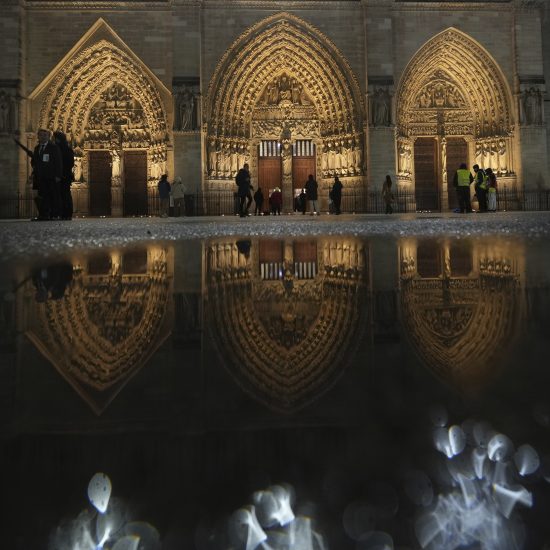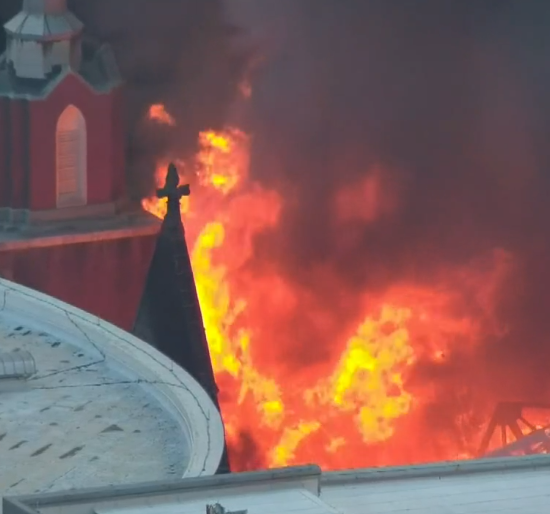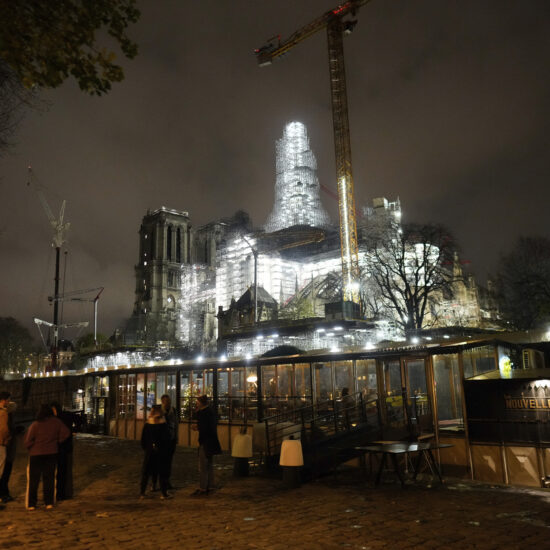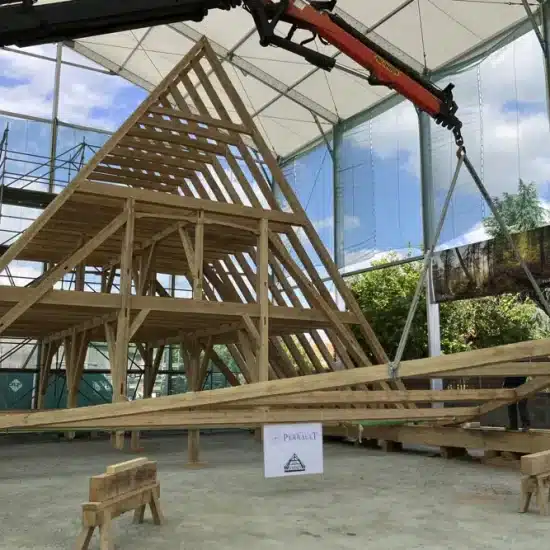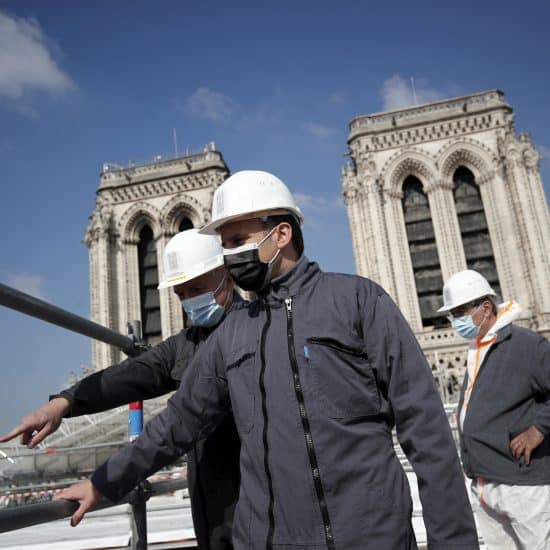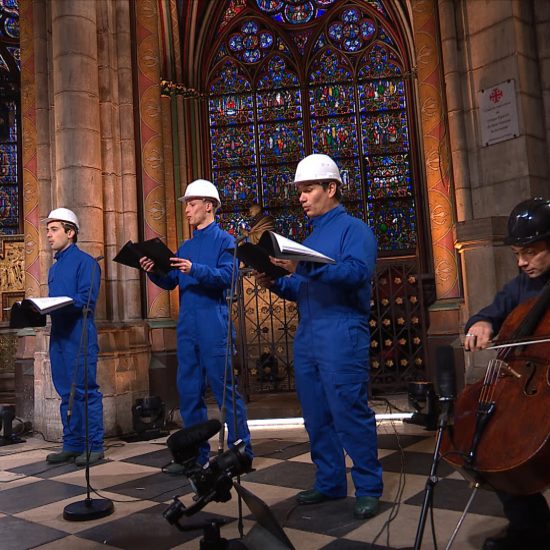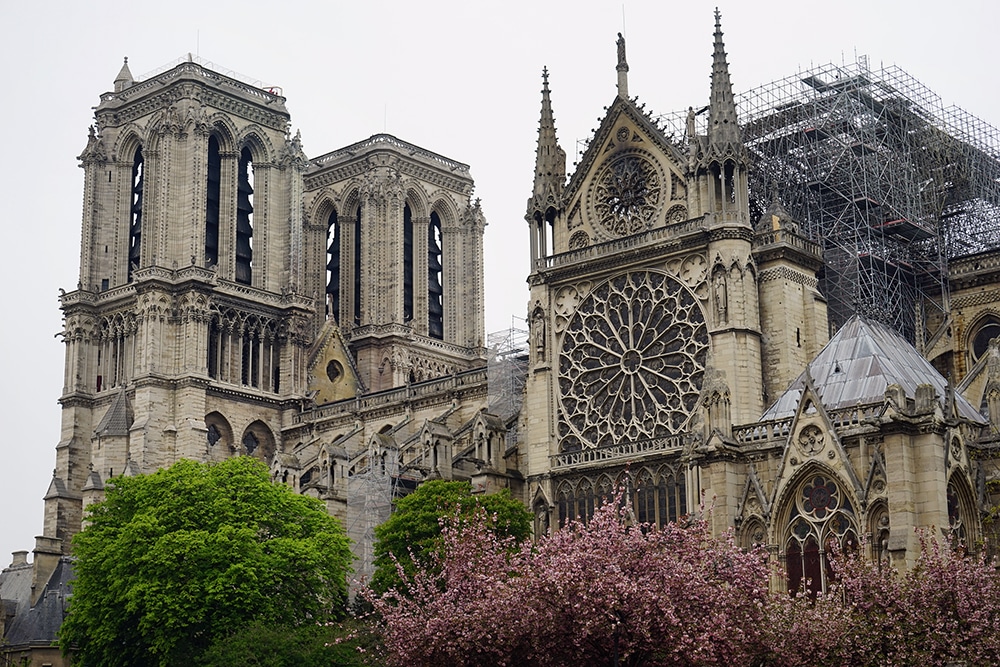
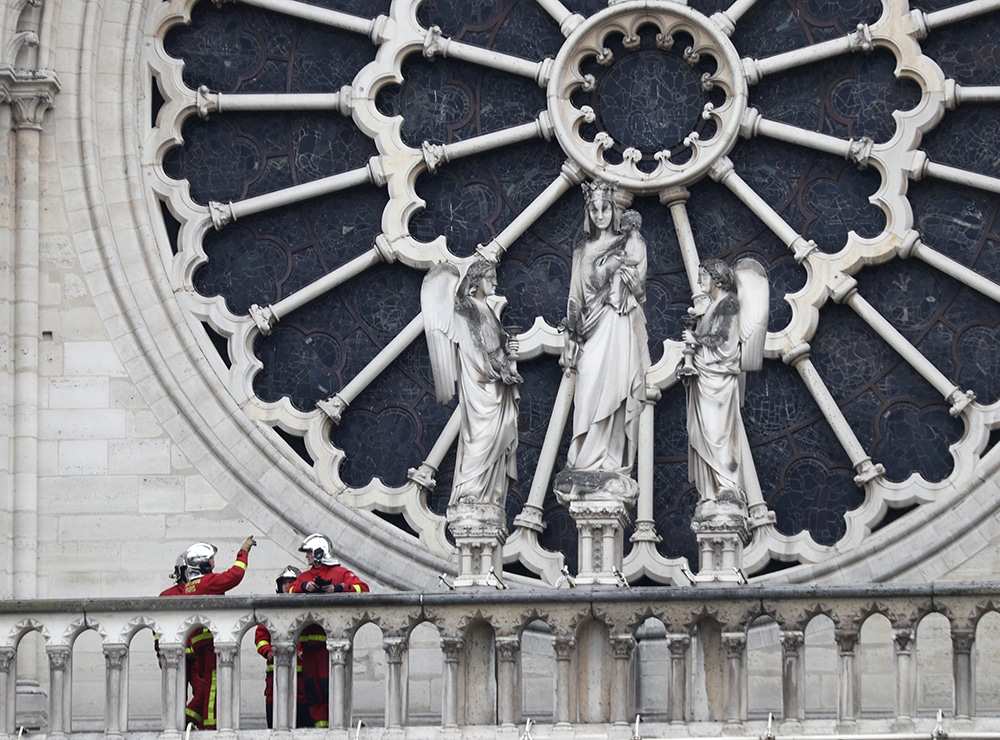
Parisian firefighters talk near the rose window of Notre Dame Cathedral on April 16, 2019, in Paris. Experts assessed the blackened shell of Paris’ iconic Notre Dame Tuesday morning to establish next steps to save what remains after a devastating fire destroyed much of the cathedral that had survived almost 900 years of history. (AP Photo/Thibault Camus)
PARIS (RNS) — The last flames have been extinguished and the first sighs of relative relief have been breathed. It’s now up to the experts to assess how much the shell of Notre Dame Cathedral in Paris has been damaged and how many years, maybe decades, it will take to repair it.
Paris, all of France and people watching live television around the world held their breath on Monday evening (April 15) as a sudden fire in the 850-year-old edifice devoured the roof, felled the elegant spire that stood atop its transept and spread down into the nave to threaten priceless relics and artworks.
About 400 firefighters battled the blaze, pumping water into the nave and trying to keep flames away from the giant stained glass rose windows and the endangered northern bell tower of the most visited monument in Europe.
President Emmanuel Macron and Paris Mayor Anne Hidalgo took a quick look inside the building on Monday evening as firefighters still fought the blaze. Macron emerged to announce that France would rebuild the state-owned cathedral “because that’s what the French expect, because that’s what our history deserves, because it’s our profound destiny.”
Hidalgo described a hole in the roof where the spire crashed through but added a hopeful note.
“The altar and its cross were preserved,” she said. “It’s less terrible than I feared.”
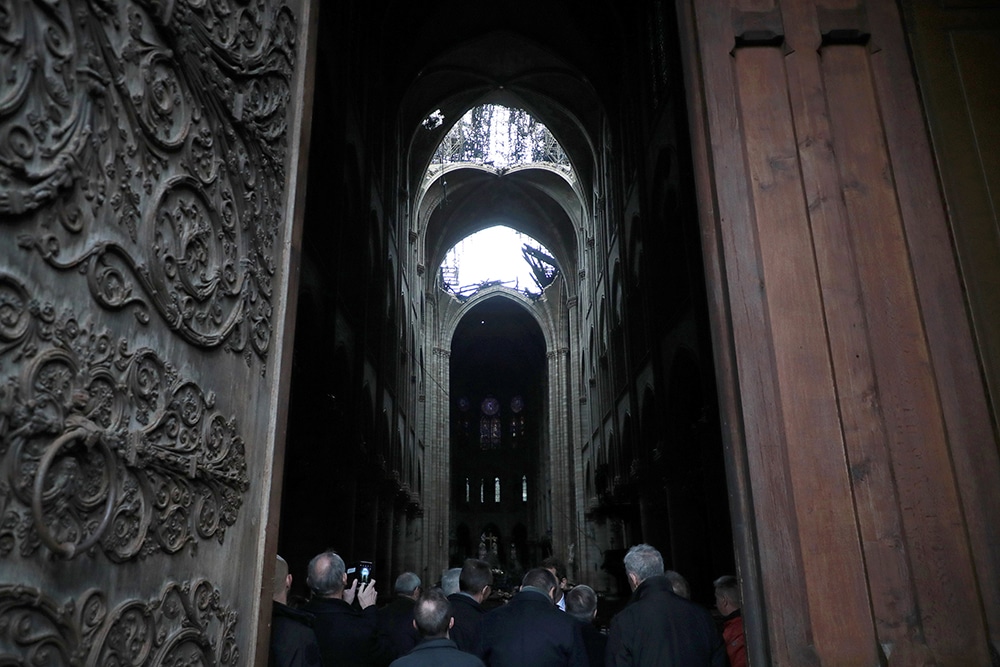
Holes are seen in the Notre Cathedral ceiling in Paris, on April 16, 2019. Firefighters declared success Tuesday in a more than 12-hour battle to extinguish an inferno engulfing Paris’ iconic Notre Dame Cathedral that claimed its spire and roof, but spared its bell towers and the purported Crown of Christ. (Christophe Petit Tesson, Pool via AP)
Standing outside the monument on Tuesday, Paris prosecutor Rémy Heitz contradicted speculation that the fire was an attack on Notre Dame.
“There is nothing that indicates a voluntary act,” he said. His office announced it had opened an inquiry into a case of “involuntary destruction by fire.”
Reconstruction will probably take decades and cost hundreds of millions of euros.
Stéphane Bern, 55, a well-known filmmaker and specialist in French history, lamented: “My generation will not see Notre Dame back on its feet again.”
The investigation will be “long and complex,” Heitz warned, adding that his staff had begun quizzing several dozen workers who had been doing renovation work on the roof. All had already called it a day on Monday before the fire broke out about 6:20 p.m. Paris time.
The spire that fell amid the flames was due to be repaired and 16 statues that surrounded it had already been removed last week. Scaffolding over that part of the roof was still standing on Tuesday as Parisians and tourists flocked to the streets around Notre Dame to catch a glimpse of the damage.
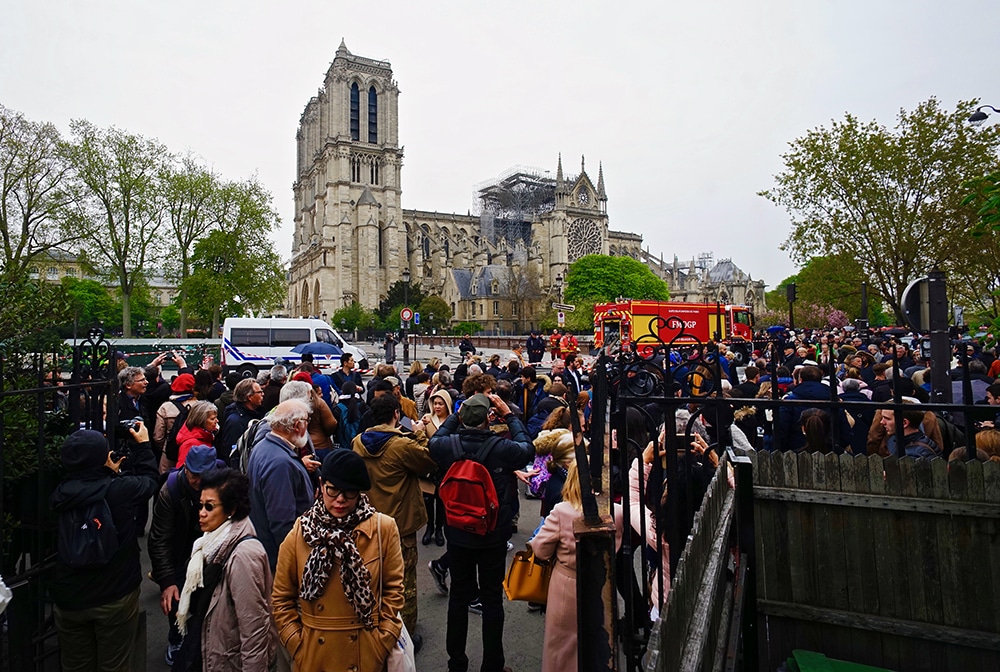
Large crowds of Parisians and tourists gather near Notre Dame Cathedral to view the fire damage on April 16, 2019, in central Paris. RNS photo by Tom Heneghan
The cathedral roof was entirely gone after the “charpente,” the thick network of wooden supports between the vaulted stone ceiling of the cathedral and the peaked roof of lead tiles above it, burst into flames. Burned timber and tiles crashed into the cathedral, mixing into sludge with the water pumped in to put out the fire.
Embers from the spire and roof were still smoldering on Tuesday morning around the modern altar, at the intersection of the nave and transept, and parts of the wood-paneled choir stalls leading to the old altar at the back of the cathedral appeared burned in photographs published from inside.
But a wreath said to be the crown of thorns that Jesus wore was saved, as was a tunic of St. Louis, the 13th-century French king and saint who bought this and other relics and brought them to his capital.
The Treasury, a museum of chalices, vestments and artwork down the centuries not far from the choir area, was also untouched.
Some but not all of the centuries-old paintings from the side chapels were rushed out to the nearby Paris City Hall, officials said, and firefighters kept sprinkling the rose windows to avoid them overheating and falling apart.
The grand organ, another of the jewels of Notre Dame, was “a priori” saved from the flames, but would probably have to be dismantled and rebuilt, church officials added.
“It was a stroke of luck, because that is an irreplaceable part of our national heritage,” said Olivier Latry, one of the cathedral’s three organists. Latry, who recently recorded a selection of Johann Sebastian Bach’s organ works there, last played in the cathedral on Sunday evening.
The cathedral’s north bell tower, the one to the left when visitors approach the main entrance, was in danger of catching fire on Monday evening but firefighters were able to keep the flames at bay. Had the blaze reached it, its eight bells could have crashed to the ground, bringing down the tower and probably its southern twin as well.
Over the next few days, architects must examine the standing stone structure to see if the blaze caused any structural damage to the Paris limestone that was heated to several hundred degrees and then doused with cold water pumped in from the Seine river just outside.
Offers to contribute to the reconstruction of the building poured in, with over 600 million euros pledged by rich French businesses and several private funds launched on the internet. A national collection announced by Macron began taking pledges at midday.
A large timber company offered its best oak to rebuild the roof supports, but it was not sure it could duplicate the massive beams that dated back to the 13th century. The cathedral in the northern French city of Reims was rebuilt after its almost complete destruction in World War I with supports of reinforced concrete.

Notre Dame Cathedral the morning after a devastating fire in Paris, on April 16, 2019. The spire and roof were lost, but the famous bell towers, left, and rose windows, center, were largely spared. RNS photo by Tom Heneghan
Outside the cathedral, the gray skies provided the perfect backdrop for a melancholy Tuesday morning, as throngs of people headed to the riverbank to gaze at Notre Dame de Paris and breathe a sigh of relief that it still stood.
Crowds lined the riverbank on both sides, and on nearby bridges.
Sylvain Lam, a lifelong Parisian, said the church represented French identity and French history. He had watched the fire on television the night before and wanted to stop on his way to work to see the church in person.
“It’s attached to our French roots, our Catholic roots, our Christian roots,” he said.
Another Parisian, Sylvain Sanchez, said that he was tremendously attached to the church, despite being an atheist.
“I pass by here frequently, two or three times a month, to stop and watch the crowds,” he said.
Though not Christian, he also finds himself meditating in front of the church.
“It’s a very strong symbol of our unity, and the unity of French Christians and non-Christians,” he said.
For him, Notre Dame’s place in French culture is irrevocable and makes him think of the great French writer Victor Hugo. Hugo’s 1831 novel “Notre Dame de Paris,” known as “The Hunchback of Notre Dame” in its English translation, jumped to No. 1 on the best-seller list of Amazon in France.
British tourists Tom and Helen Ford came to see the cathedral the morning after the fire.
“It’s a symbol of Paris, and it means a lot to Parisians, especially during Holy Week,” Helen Ford said.
The fire brought to mind a similar situation in Windsor Castle 15 years ago, which saw substantial damage from a blaze.
“It will be a huge architectural and cultural challenge” to reconstruct Notre Dame, Tom Ford said. “That will cost millions and millions to repair.”
Other visitors had not yet had the chance to visit the church. Ali Ndiaye had just arrived the night before from Germany, and like so many, had been watching the flames on television.
“It’s shocking,” he said. “We were in the center of the city, watching. I’m a little sad, because I had been looking forward to seeing it.”
A Spanish student in Paris to visit friends said he was “a little bit heartbroken.”
“It’s such an important cultural space,” Ivan Magdalene said.
Others who came to view the cathedral were too upset to speak.
One elderly woman, through freely flowing tears, could not convey her thoughts. “There are no words,” she said. “There are no words.”
Traffic was severely disrupted, as much of the area around the cathedral had been roped off by police. Armed police directed traffic and the swarm of pedestrians around Ile de la Cite, while metro stations around the famed cathedral remained shut in the wake of the fire.
After the fire, messages of support and sorrow poured in from around the world. One encouraging one came from La Fenice, the opera house in Venice, Italy, that opened in 1792 and rebuilt after fires in 1836 and 1996.
The opera company, whose name means “Phoenix,” tweeted: “We burnt twice but twice we have risen from our ashes stronger. We are at your side, friends, so fear not!”
Paris Archbishop Michel Aupetit said the first message he received was from France’s Chief Rabbi Haïm Korsia.
“‘This is the place for everyone. I am crying with you,’” Aupetit quoted it as saying.
The French Council of the Muslim Faith urged France’s large Muslim community to contribute to “the reconstruction of this architectural masterpiece that is the glory of our country” and expressed “its solidarity and fraternity with Christians around the world.”
François Clavairoly, president of the Protestant Federation of France, tweeted “solidarity and fraternal thoughts in Christ to all Christians and to all those for whom this exceptional symbol has meaning.”
The central place Notre Dame has in France’s national heritage was apparent when a caller to FranceInfo radio broke down in tears trying to explain his sorrow.
“I’m an atheist and I’m always bad-mouthing the clergy, but this is 850 years of our history that’s gone up in fire,” the caller said.

